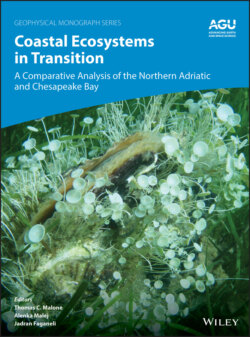Читать книгу Coastal Ecosystems in Transition - Группа авторов - Страница 38
2.6. IMPLICATIONS AND RECOMMENDATIONS
ОглавлениеAnthropogenic riverine inputs of N, P, and sediment have led to undesirable consequences in the coastal marine environment, including eutrophication and associated oxygen depletion, declines in water transparency, loss of submerged aquatic vegetation, and shifts in the composition of plankton communities (Boesch et al., 2001; Breitburg et al., 2018; Cloern, 2001; Degobbis, 1989; Diaz & Rosenberg, 2008; Giani et al., 2012; Kemp et al., 2005). Therefore, reduction of watershed inputs has been a management priority for many coastal marine systems, including CB and the NAS. A review of parallel time‐series data on hypoxia and watershed loading rates in coastal ecosystems shows that oxygen conditions tend to improve rapidly and linearly when the primary driver targeted for control is nutrients from wastewater treatment plants (Kemp et al., 2009). In larger more open systems, where nonpoint nutrient loads are more important in fueling eutrophication, responses to remediation tend to be nonlinear with hysteresis and time‐lags. Nonetheless, there have been some signs of ecosystem recovery. For CB, water quality improved with time during 1985–2016, which is statistically linked to the reduction of riverine inputs of TN (Zhang et al., 2018). For the NAS, the reduction of riverine loads of P has been an effective method to alleviate eutrophication, even with high inputs of N and silicates (Djakovac et al., 2012; Giani et al., 2012). However, ecosystem conditions in this posteutrophic phase are still not comparable to those in pristine environments due to the occurrence of hypoxia and degraded benthic habitats in shallow coastal zones (Alvisi & Cozzi, 2016; Stachowitsch, 2014). Thus, continued reduction of watershed loads is indispensable for both CB and the NAS.
After decades of management efforts, the goals of CB and the NAS restoration have not yet been fulfilled (Volf et al., 2018; Zhang et al., 2018). Moving forward, we provide the following recommendations:
continue monitoring river flows and water quality in the major tributaries to CB and the NAS;
improve statistical approaches for quantifying riverine constituent loads and trends, including associated uncertainties;
increase understanding of watershed factors that influence riverborne loads and trends (e.g., land use, hydrology, source controls) and their relative importance;
develop consensus and solutions among stakeholders to address the major challenges that hinder the achievement of restoration goals in a timely fashion (e.g., legacy sources, climate change, and reservoir filling);
increase understanding of the effects of land‐based inputs on downstream water quality and ecological responses (e.g., dissolved oxygen, water clarity, chlorophyll‐a);
enhance public awareness of the impacts of anthropogenic nutrient loading, management goals and actions, progress toward achieving these goals, and major challenges.
In a world with seemingly ubiquitous nutrient enrichment and water‐quality degradation, past and future advancement in our scientific understanding on these two coastal ecosystems can be valuable resources that may guide and facilitate the protection and restoration of estuarine and coastal ecosystems in other geographical locations.
